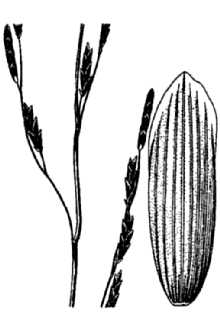Northwestern Mannagrass
Scientific Name: Glyceria ×occidentalis (Piper) J.C. Nelson

| General Information | |
|---|---|
| Usda Symbol | GLOC |
| Group | Monocot |
| Life Cycle | Perennial |
| Growth Habits | Graminoid |
| Native Locations | GLOC |
Plant Guide
Use a soil moisture meter to monitor the soil moisture where Northwestern Mannagrass is planted.
Fact Sheet
Alternate Names
Other names are Northwestern mannagrass, tall mannagrass, and waxy mannagrass.
Uses
Western mannagrass is a native species important for restoration of freshwater marshes, vernal pools, and depressions within wetland prairies. The species rapid growth, underground stems, and floating leaves aid in reducing erosion along the edges of streams and lakes where it naturally occurs. In the Pacific Northwest, this grass is recommended for use in stormwater management, including detention ponds and biofiltration swales that are wet year round. The foliage and seeds provide food and cover for waterfowl, small seed-eating birds, muskrats, and other small mammals. Western mannagrass may be useful in seed mixtures aimed at increasing plant diversity while helping deter the invasion of reed canarygrass (Phalaris arundinacea). The seed can be dried and ground into flour and was apparently eaten by Native Americans.
Status
Please consult the PLANTS Web site and your State Department of Natural Resources for this plant’s current status (e.g. threatened or endangered species, state noxious status, and wetland indicator values). Dale Darris USDA NRCS Corvallis PMC
Description and Adaptation
Adaptation
Adaptation
Western mannagrass is a short-lived, cool season perennial grass with flaccid stems (culms) that reach a height of 70 to 150 cm, The form is moderately coarse textured, clumpy, and upright to nearly flat: spreading from rhizomes or decumbent (low lying) stems that root at the nodes (joints), When submerged in spring, this species produces floating stems and leaves, but flowering is reduced, Leaf blades are ribbon-like, 4 to 13 mm wide, and 15 to 30 cm long, Flowerheads (panicles) are narrow and 15 to 40 cm long, with appressed branches and long cylindrical spikelets (the groupings of individual florets or flowers), The flowering period is long, from May to September, Western mannagrass occurs from British Columbia south to California and east to Idaho and Nevada at elevations below 4000 feet, Key to identification: Western mannagrass is easily confused with northern mannagrass (Glyceria borealis) and slender spiked mannagrass (Glyceria leptostachya) which are found in similar aquatic habitats, Western mannagrass has larger florets (individual flowers) and the seed is three times larger compared to the other two, A botanical key, scale, and hand lens are needed for proper identification, Relative abundance in the wild: This species is widely occurring and common in the Pacific Northwest at low elevations, especially along streams and in wet meadow depressions, Despite the long flowering period, seed collection is laborious because retention is poor: the seed drops (shatters) very easily when green and not fully mature, However, additional seed may be held within the lower leaf sheath and can be removed by threshing, Adaptation: This species is easy to establish and grow on adapted sites, It can volunteer readily, Western mannagrass grows naturally in vernal pools, wet depressions, marshes, and ditch bottoms, as well as along the shores of lakes, streams, and ponds, While found in full sun, it occasionally occurs in partial shade as well, Soils include poorly drained sands, loams, and clays with acid, neutral or slightly alkaline pH, This species can grow in permanent standing or slow moving water at least 30 cm deep, It is intolerant of drought and is not found on saline sites, Soil fertility requirements are moderate, , Use soil moisture sensors to measure the soil moisture of Northwestern Mannagrass.
Establishment
The seed has no physiological dormancy and germinates readily without treatment in less than three weeks. The species can be broadcast on the surface of mud or muck in the fall or spring. Moist soil is adequate for germination, but if the site is inundated prior to germination, the seed must be secured in place with a thin mulch or mat to prevent it from floating or washing away. The hull detaches readily but can be left intact. There are approximately 215,000 to 360,000 seeds/lb (+/- 20%) with and without hulls, respectively. A seeding rate of 1 lb pure live seed per acre will result in about 5 to 8 live seeds per square foot. Actual seeding rates will depend on methods, objectives, and site conditions. Western mannagrass is easily propagated by division or as container stock sown from seed and maintained in shallow standing water.
Management
There is a lack of information about the management of western mannagrass. It can be grown and maintained under continuously moist, saturated, or seasonally to permanently flooded conditions. Regeneration and spread is favored by wet open areas and disturbance. Water impoundments or other controlled wetlands should not be allowed to dry out, especially if viable seed has not yet formed.
